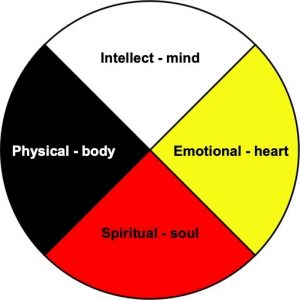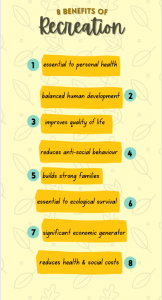Chapter 1: Recreation and Leisure Becomes an Industry
1.6 Enhancing Wellbeing
As practitioners in the Recreation and Leisure Industry we strive to enhance wellbeing for our participants. The activities vary but result in engaging the entire being to achieve wellness. One of the best depictions of this holistic approach is found within many FNMI communities through their medicine or healing wheels.

Wellbeing in FNMI communities is visually represented in a medicine or healing wheel. The medicine or healing wheel is a circle split into four quadrants, with everything being pulled towards the center. The center represents balance. Different FNMI communities will vary on the different meanings and colours of each of the quadrants, and it is important to note that not all First Nations, Métis, or Inuit people use the medicine wheel. One commonality of the wheel, across FNMI communities that use it, is the representation of the four aspects of being: Intellect, Emotional, Spiritual, and Physical. For good health and a happy life, these four aspects pull to the centre in balance. Many wheels also depict this holistic approach towards communities and the environment. The circle represents the continuity of connection to all aspects of one’s being, one’s community and the environment.
In 1992, Parks and Recreation Ontario, in partnership with the Canadian Parks and Recreation Association, produced the 8 Benefits of Recreation:

Image Description
8 Benefits of Recreation: 1) essential to personal health; 2) balanced human development; 3) improves quality of life; 4) reduces anti-social behaviour; 5) builds strong families; 6) essential to ecological survival; 7) significant economic generator; 8) reduces health & social costs.
In 2015, the Interprovincial Sport and Recreation Council and the Canadian Parks and Recreation Association created a framework for Recreation in Canada. Contained within this document are 5 Benefits of investing in Recreation.
The evidence on the benefits of recreation and exposure to nature suggests that recreation and parks can address existing challenges with policies and practices that can:
1. Enhance Mental and Physical Wellbeing:
Public recreation and parks services have an important role in enhancing physical activity, which in turn is a critical factor in improved physical and mental health. Increased physical activity levels are associated with the presence of trails for walking, hiking and cycling, and organized events, including sports competitions and other attractions. For children, the presence of a playground within a nearby park is significantly associated with enhanced levels of physical activity. Among all ages, recreational experiences involving physical activity facilitate the maintenance of healthy weights, and thus a reduction in health care costs.
Participants in recreation report improvements in mental wellbeing, including increased self-esteem and life satisfaction. Recreation provides opportunities for personal growth and development for people of all abilities and can be especially helpful to people living with disabilities.
2. Enhance Social Wellbeing:
Participation in recreational experiences is shown to enhance social wellbeing. For example, participation in after-school recreation programs provides many developmental opportunities for children and youth. For both children and adults, recreation can facilitate and support social relationships through clubs, social organizations, participating on a team or making a new friend. Among youth, recreation can help decrease anti-social behaviours.
3. Help Build Strong Families and Communities:
Recreation can be an important vehicle for promoting family cohesion, adaptability and resilience. Culture and recreation help build social capital in the form of arts, recreation and parks programs, and community celebrations, such as festivals, parades and block parties. Community events help keep neighbours in touch with each other and reinforce relationships that make neighbourhoods strong. Participation in cultural and artistic programs has been shown to promote social connectedness and social cohesion, and positively influence civic behaviour, mutual caring and voluntarism. Recreational activities can help build welcoming communities for people and families from diverse cultures.
4. Help People Connect with Nature:
Enhancing opportunities to connect people with nature can result in both environmental and human benefits. Natural playgrounds (which incorporate natural elements like logs, flowers and trees) stimulate physically active and imaginative play and help children connect with nature. Studies have shown that exposure to the natural environment and green spaces has an independent, positive effect on health and health-related behaviours. From lowering blood pressure to reducing stress levels to supporting children’s cognitive development, nature has a profound ability to support both physical and mental health. Nature-based recreation fosters a better understanding and appreciation for all aspects of nature. This may be especially important in Aboriginal communities, where fishing, hunting and nature conservation are traditional activities.
Recreation and parks have a key role as stewards of natural environments: protecting and interpreting parks, trails, waterways and wilderness areas, managing and balancing the needs of natural ecosystems with the needs of users, and minimizing any negative impacts resulting from services and programs.
5. Provide Economic Benefits:
Though economic benefit is not the primary driver for recreation service decisions, recreation is an important contributor to community economic development and cost reductions in other areas. Spending on recreation creates jobs, fosters tourism, and makes communities more attractive places in which to live, learn, work, play and visit. “Upstream” investments in recreation can lead to improvements in individual and community wellbeing, which helps to reduce costs in health care, social services and justice.
“Framework for Recreation in Canada 2015: Pathways to Wellbeing” by Canadian Parks and Recreation Association/Interprovincial Sport and Recreation Council is used under the permission of the copyright holder. All rights reserved.
Additional Benefits…
There are additional advantages to participating in recreation or leisure programs and activities, including:
Skill Development:
Many recreation programs offer opportunities for skill development, learning and personal growth. Whether getting the hang of a new sport, honing artistic talents, or mastering a hobby, participants can acquire valuable skills that enhance self-confidence and self-esteem and generally enrich their quality of life.
Promotion of Equity, Diversity and Inclusion (EDI):
Recreation and leisure programs often cater to diverse interests and abilities, making them inclusive spaces where people from different backgrounds can come together and participate equally. This promotes understanding, respect, and an appreciation for the increasingly diverse communities that exist across Canada.
The Benefits speak to wellbeing for the individual, community, and the environment. You can find each of the 4 aspects in the healing wheel (Intellect, Emotional, Spiritual and Physical) represented throughout the 5 Benefits.
 (TK CR)
(TK CR)  (TK V)
(TK V)
“2.2 Benefits of Recreation and Leisure Programs” in Program-Planning in Recreation Copyright © 2024 by Allison Menegoni, MA-Ed is licensed under a Creative Commons Attribution-NonCommercial-ShareAlike 4.0 International License, except where otherwise noted. Modifications: content added from source beginning at section “1. Enhance Mental and Physical Wellbeing onwards,” and removed the last paragraph from the original.

